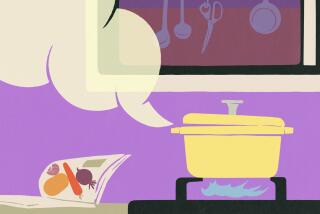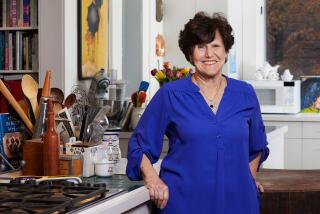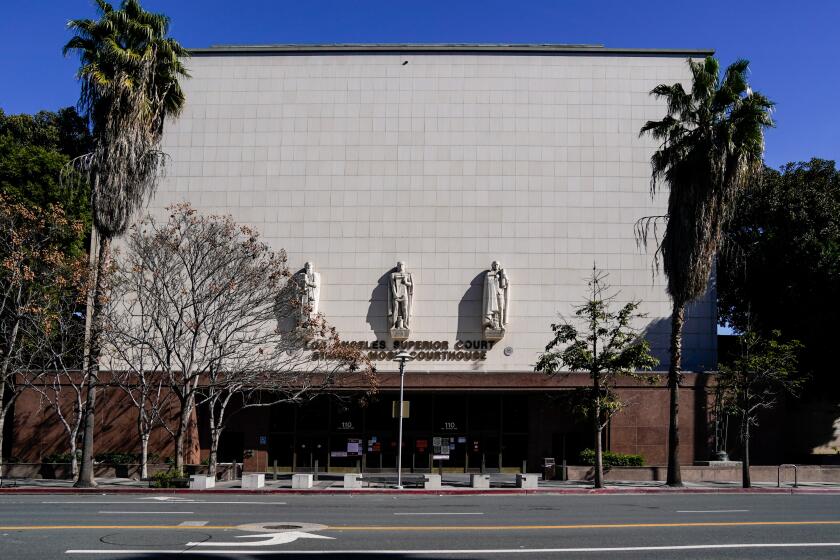How Julia Child taught me to cook -- and live
I was elbow deep in poultry, sweating, anxious, peering at the dense page of instructions in the book laid out before me. It was the first duck I’d ever tried to bone, and I was stuck. I might have remained there indefinitely, fingers frozen and numb deep in the carcass, were it not for reading what came next:
“By the time you have completed half of this, the carcass frame, dangling legs, wings, and skin will appear to be an unrecognizable mass of confusion and you will wonder how in the world any sense can be made of it all. But just continue cutting against the bone, and not slitting any skin, and all will come out as it should.”
Those were, of course, the reassuring words of the master, Julia Child, contained in “Mastering the Art of French Cooking” — for my money the greatest self-help book ever written, and not just for its approach to preparing food.
Julia, who would have turned 100 on Wednesday, was one of a handful of people who, starting in the early 1960s, radically changed the way America eats and cooks. We have her to thank (or to blame) for the Food Network and “Top Chef,” as well as for the fact that every person who graduates from culinary school now harbors the secret conviction that she will wind up a celebrity chef.
And she also helped create a culture that takes eating seriously, that sees food as not just fuel but as craft and, sometimes, art. The fact that neither “Mastering the Art of French Cooking” nor”The French Chef”have shown up on “Mad Men” suggests that Matthew Weiner might not be the infallible master of period detail we all think he is.
Julia was her own brand of feminist, one who saw the kitchen not as a symbol of drudgery and female oppression but as a place of opportunity, no less potent than a boardroom, a place where women — and men — can exhibit rigor and individual power.
She achieved all this not with manifestoes or activism but simply by dint of the way she lived. When she found something of life-changing importance to her, she devoted the rest of her life introducing others to her passion.
Along with recipes and detailed instructions for preparing the foods she loved, Julia passed along her approach to eating. She couldn’t stand “health food” and thought dieting was absurd. When asked about her “guilty pleasures,” her response was swift: “I have no guilt.”
Most of her advice was of the practical variety and had to do with focus and self-control: “Train yourself to use your hands and fingers; they are wonderful instruments. Train yourself also to handle hot foods; this will save time. Keep your knives sharp.” But, always, centrally, “Above all, have fun.” Every once in a great while she dispensed a bit of wisdom about how to live life beyond the kitchen: “Find something you’re passionate about and keep tremendously interested in it.”
It’s the “keep” that makes that advice so great. This is not just the same old “follow your bliss” pablum; it is a recognition that interest, enthusiasm and joy are hard things to maintain. They require determination, pluck — courage, even. Julia knew that it’s the work it takes that makes joy such a galvanizing force.
By the time Julia died, just short of her 92nd birthday, in 2004, I was trying to embrace her approach both to food and to life. The discipline, hard work and fascination she emphasized had led me, unexpectedly, to the beginnings of a career and, less unexpectedly but perhaps more essentially, to a truly beautiful boeuf bourguignonne.
Now I try to continue to be guided by her example. Not simply to follow my bliss but to hunt it down, nose to the ground, unrelentingly.
Though I never met Julia, she changed me, as she did so many of her other acolytes. And she did it not by writing a traditional self-help manual or a motivational seminar but with a cookbook: an exhaustive, meticulously researched, accidentally profound cookbook.
She taught me how to bone a duck, taking me step by step through an exotic new skill. And thanks to her detailed instructions, I have learned, along with an awful lot of other Americans who never would have attempted such a feat without her guidance, how to take all the meat of a bird carcass in one neat piece. And in the course of acquiring that knowledge, we’ve learned something else as well.
Sure, Julia was writing about the “unrecognizable mass of confusion” that invariably comes in the middle stage of boning a duck. But her advice can be applied to a lot more than butchery. In dark moments, in times of stress, in times of confusion, it’s worth pausing to imagine Julia’s distinct voice assuring you that, if you just pay attention and keep going, “all will turn out as it should,” including the pate de canard en croute.
Julie Powell is the author of “Julie and Julia: My Year of Cooking Dangerously.”
More to Read
A cure for the common opinion
Get thought-provoking perspectives with our weekly newsletter.
You may occasionally receive promotional content from the Los Angeles Times.






